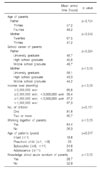Abstract
The purpose of this study was to evaluate the factors affecting the time elapsed before hospital visit after onset of acute scrotum, to contribute to early recognition of the disease and to improve the testis salvage rate. We evaluated 90 cases of patients under 18 year or age with acute scrotum, who visited the Pusan National University Hospital between March 1997 and March 2006. Clinical data were collected through telephone interviews and surveys of medical records. The time elapsed before hospital visit after onset of symptom were reviewed with regard to the age of their parents, school career and income level of parents, Nunmber of sieblings, both parents' working, age of patients, and the knowledge of their parents about acute scrotum. The mean time passed before hospital visit was 48 hrs (1~300 hrs). The causative diseases were testicular torsion, acute epididymitis, torsion of appendix testis, acute orchitis. School career of mother, income level, both parents' working and knowledge of their parents about acute scrotum had significant influence on the time passed before hospital visit after onset of symptom. Our results suggest that improvement of the testis salvage rate requires that children, their families and teachers should be aware of this disease and its sequelae through public education projects.
Figures and Tables
References
1. Oh DK, Kim SJ, Ahn HS. Experiences of 313 cases of acute scrotum: properties of acute epididymitis and differential diagnosis of testicular torsion. Korean J Urol. 2002. 43:624–630.
2. Sung GT, Kim CG, Yoon KH, Yoon JH. Torsion of the spermatic cord: the need for early recognition. Korean J Urol. 1995. 36:431–437.
3. Lee YB, Kim DS. A clinical observation on torsion of the testis. Korean J Urol. 1991. 32:932–936.
4. Lee JW, Kim YT, Lee HM. Evaluation of the acute scrotum by color Doppler ultrasonography and radioisotope imaging in children. Korean J Urol. 1996. 37:671–676.
5. Jung SI, Joo JS, Kang TW, Kwon DD, Park K, Ryu SB. Clinical characteristics of acute epididymitis in prepubertal patients. Chonnam Med J. 2007. 43:39–43.
6. Snyder HM III, Caldamone AA, Duckett JW Jr. Fleisher GR, Ludwig S, editors. Pain-scrotal. Textbook of pediatric emergency medicine. 1993. 3rd ed. Baltimore: Williams & Wilkins;382–387.
7. Siegel A, Snyder H, Duckett JW. Epididymitis in infants and boys: underlying urogenital anomalies and efficacy of imaging modalities. J Urol. 1987. 138:1100–1103.

8. McAninch JW. Tanogho EA, McAninch JW, editors. Disorders of the testis, scrotum & spermatic cord. Smith's general urology. 2000. 15th ed. New York: Appleton & Lange;684–693.
9. Melekos MD, Asbach HW. Epididymitis: aspects concerning etiology and treatment. J Urol. 1987. 138:83–86.

10. Lewis AG, Bukowski TP, Jarvis PD, Wacksman J, Sheldon CA. Evaluation of acute scrotum in the emergency department. J Pediatr Surg. 1995. 30:277–281.

12. Wilbert DM, Schaerfe CW, Stern WD, Strohmajer WL, Bichler KH. Evaluation of the acute scrotum by color-coded Doppler ultrasonography. J Urol. 1993. 149:1475–1477.

13. Burks DD, Markey BJ, Burkhard TK, Balsara ZN, Haluszka MM, Canning DA. Suspected testicular torsion and ischemia: evaluation with color Doppler sonography. Radiology. 1990. 175:815–821.

14. Maroto A, Serres X, Torrent N, Figueras M, VelayosA . Sonographic appearance of the torsion knot in spermatic cord torsion. AJR Am J Roentgenol. 1992. 159:1029–1030.

15. Levy OM, Gittelman MC, Strashun AM, Cohen EL, Fine EJ. Diagnosis of acute testicular torsion using radionuclide scanning. J Urol. 1983. 129:975–977.

16. Haynes BE, Bessen HA, Haynes VE. The diagnosis of testicular torsion. JAMA. 1983. 249:2522–2527.

17. Costabile RA, Choyke PL, Frank JA, Girton ME, Diggs R, Billups KL, et al. Variability of ischemia during spermatic cord torsion in the rat. J Urol. 1994. 151:1070–1072.

18. Sonda LP Jr, Lapides J. Experimental torsion of the spermatic cord. Surg Forum. 1961. 12:502–504.
19. Turner TT. On unilateral testicular and epididymal torsion: no effect on the contralateral testis. J Urol. 1987. 138:1285–1290.

20. Chang HJ, Lee H, Oh YH, Kim DH, Sohn HG, Ha DB, et al. False negative of Doppler ultrasonography during testis torsion in animal model. Korean J Urol. 1999. 40:1235–1240.




 PDF
PDF ePub
ePub Citation
Citation Print
Print




 XML Download
XML Download